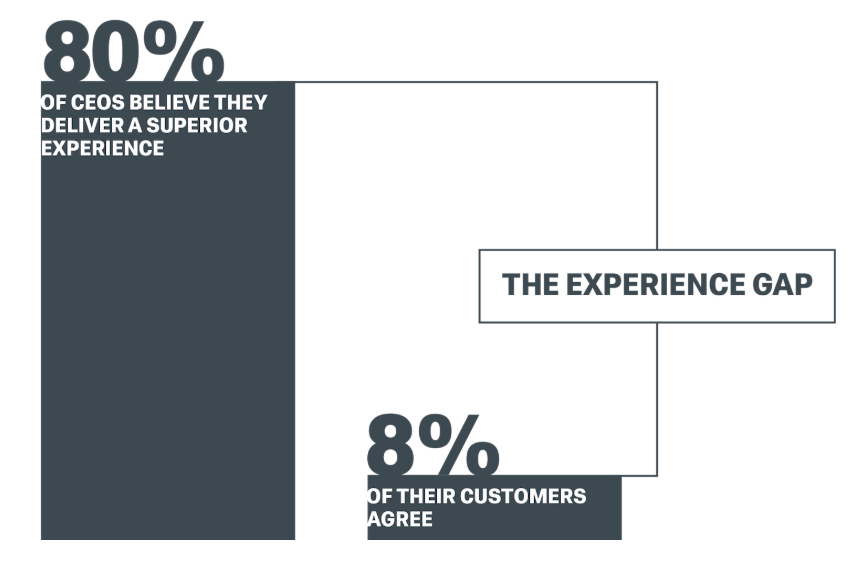These days, everyone, including myself, is talking about a great experience being the new differentiator. About product, and service being less and less of a factor distinguishing businesses.
There is talk of customer experience, user experience, brand experience, product experience, consumable experiences, but mostly this is summed up under the umbrella of customer experience.
With this, of course, businesses are reacting with creating customer experience initiatives, building strategies, and implementing solutions, from customer journey orchestration via 1 to 1 marketing solutions, or voice of customer programs.
The result is significant investment and CEOs being convinced that their customers have a very good experience. Just that their customers tend to not agree to this assessment, which leads to a considerable experience gap.

Abbildung 1: Experience Gap. Source Qualtrics
What is the experience gap? At the end of the day, it is the mismatch between brand and product promise and delivery to these promises.
This experience gap is a strong indicator that something is at odds with the assessment of the own performance. This might be a consequence of wrong KPIs, wrong measurements or, in the worst case, a wrong or failed strategy. It might also simply be a matter of confusing all these terms, that I mentioned above. So, let’s start with putting some stake in the ground by doing some definition work.
Brand Experience
On Techtarget we can read that brand experience “is a type of experiential marketing that incorporates a holistic set of conditions created by a company to influence a feeling a customer has about a particular product or company name.“ This is a very inside-out definition, which I’d like to turn around to become an outside-in definition.
Brand experience is the perception that a customer has about a brand. Brand perception gets formed by the consistency of brand promise (marketing) and delivery to the message that gets delivered by marketing. This is independent of what the message is.
Let’s look at some examples: The brand of German discounter Aldi is all about low price while being local. With that the brand is in a continuous perception battle with Lidl, a competing discounter brand. On the other end, there are high end brands that place their focus on luxury and high performance, like Italian car maker Ferrari. Both examples are success stories.
Some not so successful examples are German car maker Volkswagen trying to get into the luxury car segment with their Phaeton model. Promise and delivery did not fit in this example. Or fashion retailer Gerry Weber. Similar story, but an even worse outcome.
Product Experience
Product experience covers the customer’s perception of a product, from learning about it, up to no more using it. This covers design, usability, but also the value that the product gives to the customer, in terms of solving the customer’s problem using it (job to be done). Of course, this then also compares to the product’s price.
Employee Experience
Employee experience is the worker’s perception of their employer. This perception is built up from the first contact via the hiring process through the whole journey of being employed. This experience covers how corporate values are lived, interactions with colleagues, superiors, etc., availability and usage of technology, to count just a few topics. It also includes how empowered employees are and feel to be. A good employee experience is an important enabler for a good customer experience.
User Experience
Wikipedia defines user experience as ‘a person’s emotions and attitudes about using a particular product, system or service. It includes the practical, experiential, affective, meaningful and valuable aspects of human-computer interaction and product ownership. Additionally, it includes a person’s perceptions of system aspects such as utility, ease of use and efficiency”.
Consumable Experience
Ok, I admit it. I stole this term from friend Paul Greenberg. He coined in back in 2016 in one of his great articles. A consumable experience is essentially an individual experience. Individual experiences occur whenever a customer interacts with a product or a brand. And individual experiences can get staged, i.e. designed and then promoted, as Joseph Pine and James Gilmore already put it already back in 1998. They say that “an experience occurs when a company intentionally uses services as the stage, and goods as props, to engage individual customers in a way that creates a memorable event”. A consumable experience needs to be in line with the company messaging and positioning, be consistent with its products and services. There, e.g. is no need for fanciness at Ryan Air. The brand is all about getting from A to B cheap. This way, a consumable experience contributes to the overall customer experience.
Customer Experience
All the above types of experience contribute to the customer experience. The customer experience is where this all culminates. Wikipedia defines it as “the product of an interaction between an organization and a customer over the duration of their relationship”. Forrester Research defines customer experience as “how customers perceive their interactions with your company”. Paul Greenberg says that customer experience is “how a customer feels about a company over time”. Over time is the keyword here. So, while a consumable experience is a single experience, customer experience is kind of the sum total of all experiences, weighed over time.
Experience is Perception – but where is the value?
What one can derive from all this is that experience is all about perception. An experience is a result – an outcome – on the customer side. Customer experience is solely in the realm of the customer and hence something that can get only influenced, or partly managed by businesses.
Businesses can control their messages. It is hard for a company to influence how I got up in the morning or whether or not I had a good day with my colleagues, partner, kids.
The vehicle for this influence is the unity of different individual experiences.
Which in turn can partially be ‘supplied’ by software. I use the term supplied in quotes as the company and its software can only create engagements, which result in experiences.
While it is very plausible that customers prefer making business with companies they feel good about, the question remains what the actual value or the return on investment of customer experience is. While improved sentiment and a higher NPS might be the measurable outcomes, one could ask whether or how this can get attributed to a customer experience initiative. And more importantly: How does the value that a better experience creates for the customer translate to value for the company itself? What are the economic outcomes?
There are lots of studies that tell us that customers – especially consumers – are willing to pay more for a good experience. Here is one from Bain, one from Dimension Data, another one from Super Office, American Express, another one from Microsoft, or a study by the MIT together with Capgemini Consulting. Forrester Research already in 2016 concluded in a study that ‘Customer Experience Drives Revenue Growth’.
But again? How can a business calculate the return of a customer experience initiative – its return on experience? How to quantify it in hard currency?
Here is a framework
In order to do this it is crucial to be able to link the pay-out of an initiative to a change in customer experience. This makes it necessary to
- list and chart the journeys that are most important for your customers,
- identify KPIs that show the status and change of customer experience along these journey
- link them to a monetary value for the company
The first step into this exercise is the identification of the customer journeys that are most relevant for your customer. There is no need – yet – to dive into the importance of the touch points, this will come later. There is also no need to look into the ones that are less important for the customers, even if you look at them as being important. Focus on customer needs and desires.
Then, identify a number of, say 5 KPIs that are measurable, important for you, change with customer experience, and have a link to revenue or profitability, depending on your goals. These KPIs could be customer churn, share of wallet, customer lifetime value, cost to serve a customer, cost of sales per customer, number of customer issues, defaulting on mortgages, referrals, or many more. Which ones are important depends heavily on the industry you are working in.
It doesn’t matter if you find only 3 KPIs, but build a model, or at least a working hypothesis, that links them to the customer journeys, or parts thereof.
Do some simple surveys. Within the limits of data privacy, link what customers say about their experience to what they actually do. SAP calls this linking experience data with operational data. Doing this you can segment the (anonymized) customer base into 3 to five groups, along with their scores within the chosen KPIs. As these have a link to value, this segmentation shows where value lies, between which segments particular gaps are and hence, where the road to improvement is.
Link initiatives to the chosen KPIs via a business case that clearly shows the expected change in KPIs and choose the ones with the highest lift proposition relative to their implementation cost. Linking the benefit to the cost enables you to do two things: Staying nimble, means maintaining the ability to act small while thinking big, and to establish a prioritization of initiatives based upon customer outcomes.
Track the outcomes, i.e. the changes to the KPIs after implementing the initiatives.

